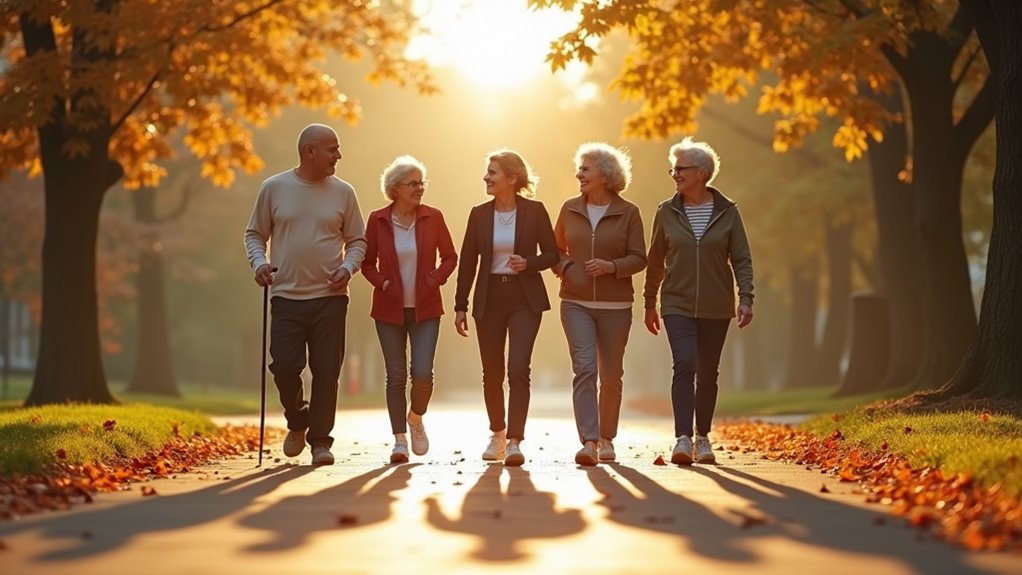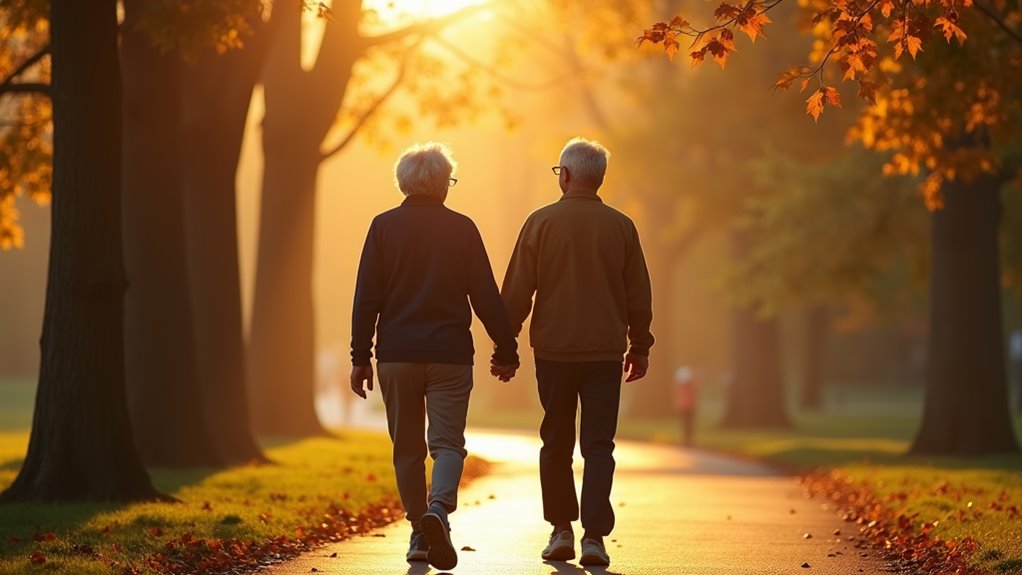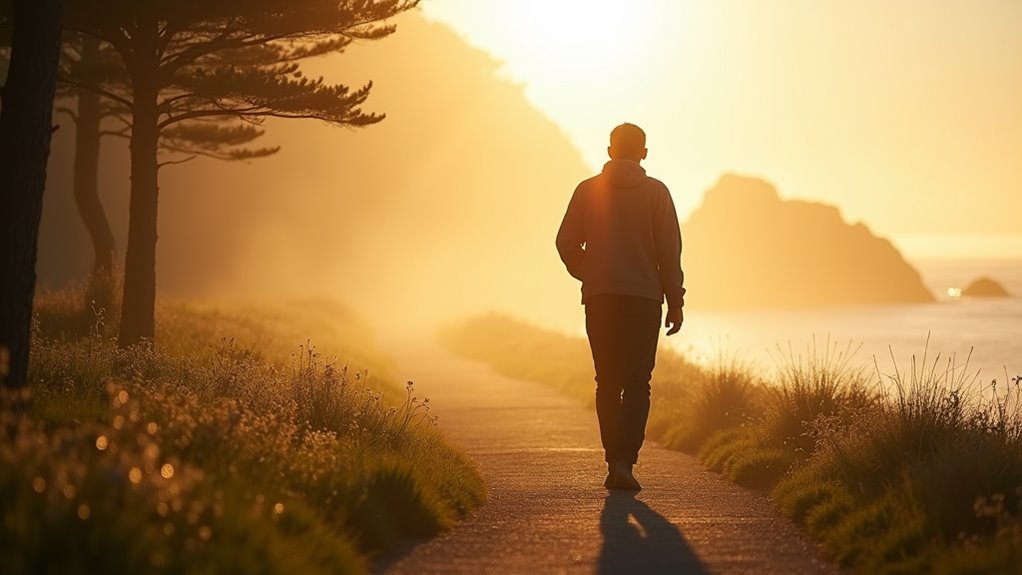Walking transforms your wellness in profound yet simple ways. You'll strengthen your heart, build muscle, and burn roughly 100 calories per mile while boosting your mood through natural endorphin release. As you walk, you're engaging in an exercise that humans evolved to do over millions of years, with your body perfectly designed for this fundamental movement. Beyond physical benefits, you'll enhance mental clarity, reduce anxiety, and potentially extend your lifespan by up to 20% with just 30 minutes daily. The path to better health starts with a single step forward.
Key Takeaways
- Regular walking improves cardiovascular health and burns 100 calories per mile, making it an accessible way to manage weight.
- Daily walking releases endorphins and neurochemicals that reduce anxiety, enhance mood, and promote mental clarity.
- Walking strengthens bones and muscles, reducing the risk of osteoporosis while improving joint flexibility and mobility.
- Thirty minutes of daily walking can reduce mortality risk by 20% and help prevent various age-related diseases.
- Group walking activities foster social connections, strengthen community bonds, and provide mutual support for maintaining fitness goals.
The Evolution of Walking

While our earliest ancestors moved on all fours, humans evolved to walk upright on two legs around 6 million years ago. This shift to bipedalism marked a crucial turning point in human development, freeing your hands for tool use and expanding your brain's cognitive abilities.
You're designed to be a walking machine. Your spine's S-curve, pelvis shape, and leg muscles work together to make walking efficient and natural. Your feet contain 26 bones each, with arches that absorb shock and propel you forward.
Your gluteal muscles, particularly your gluteus maximus, have developed specifically to keep you stable and upright while walking.
This evolutionary adaptation didn't just change how you move—it transformed how you think, socialize, and survive in your environment.
Physical Health Benefits
When it comes to physical health, regular movement delivers profound benefits throughout your body.
You'll notice improvements in cardiovascular health as walking strengthens your heart, reduces blood pressure, and increases circulation. Your muscles and bones become stronger, helping prevent osteoporosis and maintaining balance as you age.
Regular movement also boosts your metabolism, aids in weight management, and helps regulate blood sugar levels.
You'll enhance your joint flexibility and reduce stiffness, particularly in your hips and knees. Movement even strengthens your immune system, making you more resilient against illness.
As you walk, your body releases endorphins that reduce inflammation and manage pain naturally.
You'll also improve your posture and coordination, reducing your risk of falls and injuries.
Mental Clarity and Focus

When you move your body regularly, you'll notice a remarkable shift in how your mind processes daily stressors.
Physical activity triggers the release of endorphins and other mood-enhancing chemicals that help restore balance to your brain chemistry.
You'll find your thoughts become clearer and anxiety diminishes as movement creates a natural pathway to mental equilibrium.
Stress Melts Away
As your body moves through physical activity, stress hormones like cortisol begin to dissipate, leaving you with a clearer mind and sharper focus.
Your muscles release tension, your breathing deepens, and you'll notice your shoulders dropping away from your ears as anxiety melts away.
You're creating a natural buffer against daily pressures when you make movement a regular part of your routine.
Whether you're taking a brisk walk, stretching, or dancing, you'll tap into your body's built-in stress management system.
Each step helps activate your parasympathetic nervous system – your body's "rest and digest" mode – which counters the fight-or-flight response that often accompanies stress.
You'll find that even 10 minutes of movement can shift your mental state from overwhelmed to balanced.
Brain Chemistry Rebalances
Physical activity's impact on your brain goes far beyond stress relief. When you move, your brain releases a cocktail of beneficial neurochemicals, including dopamine, serotonin, and norepinephrine.
These chemicals work together to sharpen your focus and elevate your mood. You'll notice improved cognitive function within minutes of starting exercise. Your brain processes information more efficiently, and you'll find it easier to concentrate on tasks.
Regular movement also stimulates the production of BDNF (Brain-Derived Neurotrophic Factor), which helps create new neural connections and protects existing brain cells.
This process enhances your memory and learning capabilities. Whether you're tackling a complex project or learning a new skill, the mental clarity you gain through movement gives you a decisive edge.
Walking for Weight Management
Walking provides one of the most accessible and effective ways to manage your weight. You'll burn approximately 100 calories per mile at a moderate pace, and you can easily increase calorie burn by walking faster or tackling hills.
The beauty of walking lies in its sustainability – you're more likely to stick with it long-term compared to intense exercise programs.
When you walk regularly, you'll boost your metabolism even during rest periods. You can maximize weight management benefits by walking after meals, which helps regulate blood sugar and improves digestion.
Try breaking up your walking into shorter sessions throughout the day if you can't commit to longer stretches. Even 10-minute walks add up, and you'll find it easier to maintain a healthy weight without extreme dietary restrictions.
Social Connection Through Movement

You'll find meaningful social connections through various movement activities, from joining neighborhood walking groups to participating in exercise classes.
When you share physical activities with others, you're likely to develop friendships based on common fitness goals and mutual encouragement.
Whether you're meeting new people in a yoga studio or catching up with a regular walking partner, movement creates natural opportunities for social bonding and community building.
Group Walks Build Community
Although solitary walks offer many benefits, group walks can transform a simple activity into a powerful community-building experience. When you join a walking group, you'll create meaningful connections while improving your health. You'll discover shared interests, exchange ideas, and form friendships that extend beyond your walking sessions.
Group walks provide built-in accountability and motivation, making it easier to maintain a consistent exercise routine. You'll find yourself looking forward to these social outings, where conversations flow naturally as you explore neighborhoods or trails together.
Whether you're participating in a structured walking club or an informal neighborhood group, you're contributing to a stronger, more connected community. These shared experiences help break down social barriers and create lasting bonds between people who mightn't otherwise meet.
Exercise Classes Foster Friendships
Similar to group walks, exercise classes create natural opportunities for social connection while improving physical fitness.
You'll find yourself naturally bonding with others as you share the challenges and victories of learning new moves and pushing through tough workouts together.
Exercise classes provide structured environments where you can meet people who share your wellness goals.
Whether you're attending yoga, spin, or dance fitness, you'll interact with the same familiar faces each week.
These consistent encounters often develop into meaningful friendships as you encourage each other during class and chat before and after sessions.
You might even find yourself making plans to grab coffee or schedule other activities with your new fitness friends, expanding your social circle beyond the gym walls.
Walking Partners Share Goals
Having a dedicated walking partner amplifies both motivation and social rewards.
When you share your fitness journey with someone else, you're more likely to stick to your goals and show up consistently. Your walking partner becomes both an accountability buddy and a source of encouragement during challenging days.
You'll find that conversations flow naturally during walks, creating space for meaningful connections.
As you and your partner progress together, you'll celebrate shared milestones and support each other through setbacks.
The mutual commitment often extends beyond exercise, as you might find yourself discussing nutrition choices, stress management, and other wellness goals.
Walking partners frequently develop lasting friendships built on common health aspirations and the shared experience of moving forward, both literally and figuratively.
Building a Walking Routine
Starting up a walking routine can feel overwhelming at first, but breaking it down into manageable steps makes it achievable.
Begin by selecting a consistent time each day when you're most likely to follow through, whether it's early morning or after work. Choose comfortable shoes and weather-appropriate clothing to prevent discomfort.
Start with short 10-minute walks and gradually increase duration as your stamina builds. You'll want to track your progress using a fitness app or simple journal to stay motivated.
Set specific, realistic goals like walking three times per week or reaching 2,000 steps daily. Remember to listen to your body and adjust your pace accordingly.
As you develop the habit, you'll find it easier to incorporate longer walks and more challenging routes into your schedule.
Walking and Longevity

While many seek complex solutions for extending life, research consistently shows that regular walking can add years to your lifespan.
Studies indicate that walking just 30 minutes daily can reduce mortality risk by up to 20%. It's not just about living longer – it's about living better through your later years.
You'll find that walking helps prevent age-related diseases like heart disease, diabetes, and certain cancers. It strengthens your bones, reducing the risk of osteoporosis and fractures as you age.
Your brain benefits too, as regular walking helps maintain cognitive function and may lower the risk of dementia. Even moderate walking speeds of 2-3 miles per hour can provide these longevity benefits, making it one of the most accessible ways to invest in your future health.
Environmental Impact of Walking
Beyond its personal health benefits, walking offers a powerful way to reduce your environmental footprint. When you choose to walk instead of drive, you'll eliminate vehicle emissions that contribute to air pollution and climate change. A single mile of walking instead of driving prevents about one pound of carbon dioxide from entering the atmosphere.
Walking requires no fuel except the food you already eat and creates no harmful byproducts. You'll help reduce noise pollution, traffic congestion, and the demand for parking spaces in urban areas.
Frequently Asked Questions
Is Barefoot Walking Better for Health Than Wearing Shoes?
You'll find both benefits and risks to barefoot walking.
It can strengthen foot muscles, improve balance, and enhance sensory feedback from your feet. However, you're also exposing yourself to potential injuries from sharp objects, extreme temperatures, and harmful bacteria.
It's best to start gradually on safe surfaces like grass or sand, and you'll want to maintain awareness of your surroundings while walking shoeless.
What Should I Do if I Experience Shin Splints While Walking?
You're likely experiencing shin splints because of sudden increases in activity or improper footwear.
To ease the pain, try the RICE method: Rest your legs, Ice the affected area, Compress with a bandage, and Elevate your feet.
Strengthen your lower legs with toe raises and calf stretches. If you continue walking, reduce your intensity and distance temporarily, and ensure you're wearing supportive shoes with good shock absorption.
How Does Walking Compare to Running in Terms of Joint Impact?
You'll experience significantly less joint impact when walking compared to running.
When you run, you create a force of about 2.5 times your body weight on your joints, while walking only generates about 1.5 times your body weight.
Walking is gentler on your knees, hips, and ankles because one foot always stays in contact with the ground, creating a smoother motion and less jarring impact.
Can Walking Help Reduce Varicose Veins?
Did you know that regular walking can reduce your risk of varicose veins by up to 30%?
When you walk, you're helping your leg muscles contract and relax, which assists in pumping blood back to your heart more efficiently. This improved circulation helps prevent blood from pooling in your legs, a major cause of varicose veins.
You'll get the best results by walking at least 30 minutes daily, ideally on varied terrain.
Should I Walk Before or After Meals for Optimal Blood Sugar Control?
You'll get the best blood sugar control by walking both before and after meals, but post-meal walks are especially effective.
Taking a 10-15 minute walk within 30 minutes after eating can significantly lower blood sugar spikes, as your muscles use the glucose from your meal for energy.
If you can't do both, prioritize after-meal walks for optimal blood sugar management.
Conclusion
As you weave walking into the tapestry of your daily life, you'll discover it's more than just putting one foot in front of the other. You're taking steps toward better health, clearer thinking, and deeper connections with others and nature. Whether you're strolling through a park or power walking to work, each step brings you closer to your wellness goals and a more sustainable future.

Leave a Reply